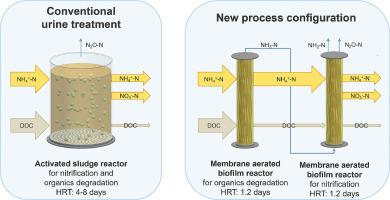当前位置:
X-MOL 学术
›
Water Res.
›
论文详情
Our official English website, www.x-mol.net, welcomes your
feedback! (Note: you will need to create a separate account there.)
Increasing urine nitrification performance with sequential membrane aerated biofilm reactors
Water Research ( IF 11.4 ) Pub Date : 2024-06-29 , DOI: 10.1016/j.watres.2024.122019 Aurea Heusser 1 , Isolde Wackernagel 2 , Mauro Reinmann 2 , Kai M Udert 1
Water Research ( IF 11.4 ) Pub Date : 2024-06-29 , DOI: 10.1016/j.watres.2024.122019 Aurea Heusser 1 , Isolde Wackernagel 2 , Mauro Reinmann 2 , Kai M Udert 1
Affiliation

|
This study aimed to investigate whether separating organics depletion from nitrification increases the overall performance of urine nitrification. Separate organics depletion was facilitated with membrane aerated biofilm reactors (MABRs). The high pH and ammonia concentration in stored urine inhibited nitrification in the first stage and therewith allowed the separation of organics depletion from nitrification. An organics removal of 70 % was achieved at organic loading rates in the influent of 3.7 gCOD d−1 m−2 . Organics depletion in a continuous flow stirred tank reactor (CSTR) for organics depletion led to ammonia stripping through diffused aeration of up to 13 %. Using an MABR, diffusion into the lumen amounted for 4 % ammonia loss only. In the MABR, headspace volume and therefore ammonia loss through the headspace was negligible. By aerating the downstream MABR for nitrification with the off-gas of the MABR for organics depletion, 96 % of the ammonia stripped in the first stage could be recovered in the second stage, so that the overall ammonia loss was negligibly low. Nitrification of the organics-depleted urine was studied in MABRs, CSTRs, and sequencing batch reactors in fed batch mode (FBRs), the latter two operated with suspended biomass. The experiments demonstrated that upstream organics depletion can double the nitrification rate. In a laboratory-scale MABR, nitrification rates were recorded of up to 830 mgN L −1 d−1 (3.1 gN m−2 d−1 ) with ambient air and over 1500 mgN L −1 d−1 (6.7 gN m−2 d−1 ) with oxygen-enriched air. Experiments with a laboratory-scale MABR showed that increasing operational parameters such as pH, recirculation flow, scouring frequency, and oxygen content increased the nitrification rate. The nitrification in the MABR was robust even at high pH setpoints of 6.9 and was robust against process failures arising from operational mistakes. The hydraulic retention time (HRT) required for nitrification was only 1 to 2 days. With the preceding organics depletion, the HRT for our system requires 2 to 3 days in total, whereas a combined activated sludge system requires 4 to 8 days. The N2 O concentration in the off-gas increases with increasing nitrification rates; however, the N2 O emission factor was 2.8 % on average and independent of nitrification rates. These results indicate that the MABR technology has a high potential for efficient and robust production of ammonium nitrate from source-separated urine.
中文翻译:

使用连续膜曝气生物膜反应器提高尿液硝化性能
本研究旨在探讨将有机物消耗与硝化分离是否可以提高尿液硝化的整体性能。膜曝气生物膜反应器 (MABR) 促进了单独的有机物去除。储存尿液中的高 pH 值和氨浓度抑制了第一阶段的硝化作用,从而使有机物消耗与硝化作用分离。在进水有机负荷率为 3.7 gCOD d−1 m−2 时,有机物去除率达到 70%。用于去除有机物的连续流搅拌釜反应器 (CSTR) 中的有机物去除导致通过高达 13% 的扩散曝气进行氨汽提。使用 MABR,扩散到管腔中的氨仅损失 4%。在 MABR 中,顶部空间体积以及因此通过顶部空间的氨损失可以忽略不计。通过将MABR的废气通入下游MABR进行硝化以去除有机物,第一阶段汽提的氨的96%可以在第二阶段回收,因此总体氨损失低到可以忽略不计。在 MABR、CSTR 和分批补料模式 (FBR) 的序批式反应器中研究了有机物贫化尿液的硝化作用,后两者使用悬浮生物质运行。实验表明,上游有机物的消耗可以使硝化速率加倍。在实验室规模的 MABR 中,环境空气的硝化速率高达 830 mgNL−1 d−1 (3.1 gN m−2 d−1),而硝化速率则超过 1500 mgNL−1 d−1 (6.7 gN m−2 d−1)。 −1) 使用富氧空气。实验室规模的 MABR 实验表明,增加 pH 值、再循环流量、冲刷频率和氧含量等操作参数可提高硝化速率。 即使在 6.9 的高 pH 设定值下,MABR 中的硝化作用也很强劲,并且能够抵御因操作错误而导致的工艺故障。硝化所需的水力停留时间(HRT)仅需1至2天。由于前面的有机物消耗,我们系统的 HRT 总共需要 2 至 3 天,而组合活性污泥系统需要 4 至 8 天。废气中的N2O浓度随着硝化速率的增加而增加;然而,N2O 排放因子平均为 2.8%,且与硝化速率无关。这些结果表明,MABR 技术具有从源头分离的尿液中高效、稳定生产硝酸铵的巨大潜力。
更新日期:2024-06-29
中文翻译:

使用连续膜曝气生物膜反应器提高尿液硝化性能
本研究旨在探讨将有机物消耗与硝化分离是否可以提高尿液硝化的整体性能。膜曝气生物膜反应器 (MABR) 促进了单独的有机物去除。储存尿液中的高 pH 值和氨浓度抑制了第一阶段的硝化作用,从而使有机物消耗与硝化作用分离。在进水有机负荷率为 3.7 gCOD d−1 m−2 时,有机物去除率达到 70%。用于去除有机物的连续流搅拌釜反应器 (CSTR) 中的有机物去除导致通过高达 13% 的扩散曝气进行氨汽提。使用 MABR,扩散到管腔中的氨仅损失 4%。在 MABR 中,顶部空间体积以及因此通过顶部空间的氨损失可以忽略不计。通过将MABR的废气通入下游MABR进行硝化以去除有机物,第一阶段汽提的氨的96%可以在第二阶段回收,因此总体氨损失低到可以忽略不计。在 MABR、CSTR 和分批补料模式 (FBR) 的序批式反应器中研究了有机物贫化尿液的硝化作用,后两者使用悬浮生物质运行。实验表明,上游有机物的消耗可以使硝化速率加倍。在实验室规模的 MABR 中,环境空气的硝化速率高达 830 mgNL−1 d−1 (3.1 gN m−2 d−1),而硝化速率则超过 1500 mgNL−1 d−1 (6.7 gN m−2 d−1)。 −1) 使用富氧空气。实验室规模的 MABR 实验表明,增加 pH 值、再循环流量、冲刷频率和氧含量等操作参数可提高硝化速率。 即使在 6.9 的高 pH 设定值下,MABR 中的硝化作用也很强劲,并且能够抵御因操作错误而导致的工艺故障。硝化所需的水力停留时间(HRT)仅需1至2天。由于前面的有机物消耗,我们系统的 HRT 总共需要 2 至 3 天,而组合活性污泥系统需要 4 至 8 天。废气中的N2O浓度随着硝化速率的增加而增加;然而,N2O 排放因子平均为 2.8%,且与硝化速率无关。这些结果表明,MABR 技术具有从源头分离的尿液中高效、稳定生产硝酸铵的巨大潜力。
















































 京公网安备 11010802027423号
京公网安备 11010802027423号